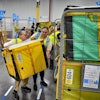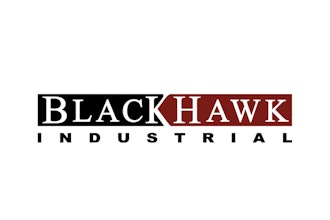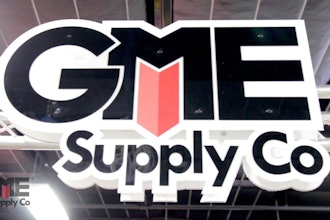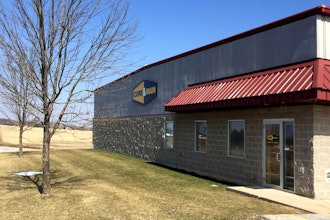
Epicor
An Epicor® White Paper
Growing a Modern, Integrated
Distribution Business
Growing a Modern, Integrated Distribution Business
i
Executive Overview
In recent years, distributors have seen their markets drastically change with new competitors and
new product categories appearing almost daily, and customers wanting to change the way they
buy products and services. And when markets change, distributors must change.
One thing most needed in any time of change is a way to think about the alternatives in front
of you. This paper presents a way of thinking about how these alternatives serve to grow and
defend your business.
The paper presents a framework of five objectives based on the customer lifecycle that every
distributor should consider when making investment decisions for their business. Without being
overly prescriptive, this paper attempts to provide a starting place for imagining how your choices
will affect you, your customers, and your employees.
Growing a Modern, Integrated Distribution Business
ii
Table of Contents
Executive Overview .................................................................................... i
Distributor Aspirations ...............................................................................1
What does a modern distributor look like? ........................................1
What challenges does a modern distributor face? ...............................1
Solution Framework & Requirements ........................................................2
1. Attract and sell to eCommerce shoppers ........................................3
2. Convert one-time shoppers into business accounts .........................4
3. Become the preferred supplier in your field ....................................5
4. Optimize for business efficiency ......................................................6
5. Defend your current accounts .........................................................7
Summary ...................................................................................................8
Growing a Modern, Integrated Distribution Business
Distributor Aspirations
What does a modern distributor look like?
Today’s modern distributor is an increasingly technology-dependent, but customer-driven, logistics
services firm. The logistics “back end” of the business uses information to keep orders, products
and money flowing in a coordinated, timely manner. Meanwhile, tight integration connects
vendors, service suppliers and customers into an efficient order-taking and fulfillment process.
The business “front end” for a modern distributor is usually composed of customers, vendors,
activities and relationships supported by sales personnel, websites, eCommerce processes and
custom services. Underneath all these activities resides a business system that provides overall
coordination and meaningful visibility into this continuously changing flow of goods, services
and information.
Like most businesses, distributors need stable growth and profitability, or the owners will choose
to exit the business. Continuing efficiency improvements are needed to compete effectively in
today’s market and to fund the costs of acquiring new customers and expanding services.
What challenges does a modern distributor face?
Today’s modern distributor faces challenges coming from many directions simultaneously.
Some of the most serious challenges found at the top of recent surveys1 are rising customer
service expectations, a pressing need to find and retain qualified employees, changing business
processes, and tight vendor and customer connections.
XX Customer expectations continue to rise as Internet use continues to increase and a
fast, efficient eCommerce experience comes to be expected in the B2B sector.
XX Finding and keeping qualified personnel—business specialization and industry
consolidation have necessitated a high reliance on hard-to-find skills. Fewer and fewer
people have the specific skills and relevant experience for any particular job. It has
become mission-critical to train and retain your best people.
XX High competitive pressure driven by consolidation and “invaders” from adjacent
markets drive business processes to become more efficient and use fewer resources.
As a result, business processes have become more automated. High levels of process
automation then change the business relationships between suppliers and customers.
XX Business relationships have become more integrated as both customers and
suppliers are driven to tightly link their automated processes together. (As relationships
become more integrated, the chosen distributors obtain an advantageous position—
and, their competitive pressures decline.) Tight integration is also less tolerant of errors,
requiring robust processes and well-trained support personnel.
With pressures from so many directions, how does a distributorship find time to grow when it
takes so much effort just to stand still?
This paper presents an integrated approach to organic growth defined from the customer
lifecycle viewpoint, and uses business efficiency gains to balance the front-end investments
needed to continuously acquire new accounts.
1 “The 68th Annual Survey of Distributor Operations”, Industrial Distribution, May/June 2015
1
Growing a Modern, Integrated Distribution Business
Solution Framework & Requirements
In today’s competitive business environment, a modern, integrated distributor needs five
identifiable groups of activities to grow and sustain the business. These activity groups fall into a
sequence when viewed from a customer “lifecycle” viewpoint, but work toward the five
goals simultaneously.
Some activities contribute to multiple business goals, making them the most valuable. The five
goals a distributor needs to pursue are:
XX Attract and sell to eCommerce shoppers
XX Convert one-time shoppers into business accounts
XX Become the preferred supplier in your field
XX Optimize for business efficiency
XX Defend your current accounts
For example, here is how these goals intertwine to create a compelling business proposal. It has
been proven that eCommerce makes business more responsive and efficient by accelerating
the business process and reducing support costs. What if, at the same time, products are priced
so that the most important products for each customer are always very competitive? And, why
would a customer leave your customer service, if you can reliably stage just-in-time deliveries to
job sites and do progress-based project billing?
eCommerce
Universe
Attract/Sell to eCommerce Shoppers
Convert Shoppers into Accounts
Become the Preferred Supplier
Optimize Your Business
Defend Your Accounts
Traditional &
Local Customers
Traditional &
Local Customers
Five Goals
for Secure Growth
2
Growing a Modern, Integrated Distribution Business
1. Attract and sell to eCommerce shoppers
The Internet can seem a crowded place, and even the most compelling message is easily lost in
the noise. An eCommerce storefront allows distributors to get found on the Web, so that two
important goals can be accomplished: find more opportunities, and evolve one-time buyers
into loyal accounts. Modern eCommerce websites provide multiple tools that attract shoppers’
attention, make the website easy to find, and promote that initial purchase.
XX 74% of all B2B purchases are preceded by Internet research1
XX U.S. B2B eCommerce in 2015 is expected to top $780 Billion, 7.7% CAGR2
The website is also a digital calling card, introducing products and services to current accounts
and the unknown Web shoppers of tomorrow. Potential customers are attracted by information
they find on the website during their Internet research stage. These shoppers are drawn to
the website, where they discover more information on products and services, and incentives
to purchase.
Some of the most critical features and functions in a modern eCommerce storefront are: search
engine optimization tools, social marketing, webpage templates, product cataloging, search tools,
promotion management tools, newsletters, shopper registration, multiple payment methods,
multiple shipping options, and other first-time shopping tools.
The initial goal is to attract shoppers to make that first-time purchase. Once that is done,
information from the initial purchase can be used for the next goal of developing accounts.
1 https://www.internetretailer.com/2015/04/02/new-report-predicts-1-trillion-market-usb2b-e-commerce
2 https://www.forrester.com/US+B2B+eCommerce+Forecast+2015+To+2020/fulltext/-/E-RES115957
ABC Parts was always
known as a great local
store where almost
any spare part for most
German autos could
be found. As a natural
progression of their local
presence, they decided
to create a webstore
that mimicked their
local business principles.
A key value that ABC
Parts provided was that
when a customer called,
the sales rep always
found the part quickly.
They translated this
key experience to their
webstore as an easy-to-
use search engine that
quickly returned the
correct results.
After the main webstore
was live, they added
e-newsletters to their
resellers/customers that
included “clickable”
links to the webstore to
complete the transaction.
ABC Parts successfully
translated their core
business values from
a “bricks-and-mortar”
local business to the
World Wide Web while
reducing transaction
costs and providing
an even better
customer experience.
3
Growing a Modern, Integrated Distribution Business
2. Convert one-time shoppers into business accounts
In this stage, the one-time buyer becomes an account that makes routine additional purchases.
Information from previous visits is used to create further interest in re-buying with “one-click”
purchasing, “wish lists,” and related product information.
Related website content can enrich the shopping experience, create an awareness of available
products, and obtain add-ons for orders. Related information may include product lists such as
what other shoppers purchased, similar products, most- purchased items, and special daily deals.
In addition to developing accounts, shoppers must be sustained and refreshed to keep them
active into the future. Much of this account retention activity occurs in eCommerce when the
shoppers visit the website to enter orders, and can also be used to defend online accounts.
A B2B eCommerce solution offers capabilities that personalize the B2B experience with
newsletters, visibility into account history and settings, multiple “wish lists,” easy re-orders, mobile
Web access, order status updates, special promotions, related product lists, abandoned cart
discounts, B2B integration capabilities, easy add-ons, and support for future eCommerce needs.
In this second goal, investments are made to convert one-time buyers into business accounts that
routinely re-buy. While the first and second goals mostly involve the front-end business processes,
the last three goals are mostly accomplished by the back-end business system.
eCommerce
Universe
Attract and Sell to eCommerce Shoppers
Convert Shoppers into Business Accounts
Business Accounts
ABC Parts was known
for their “specials” on
the Web. ABC had
always used promotions
to boost sales during
lean times. Their specials
were always featured
on consolidation sites
like techbargains.com
or slickdeals.net, where
customers would click
on the “specials” link to
complete the purchase
through the guest
checkout process.
Then ABC Parts added
a new feature where,
with a single click, a
guest shopper could
use the information
they had just entered to
become a full account.
The value proposition
to the customer was
very simple: “You have
already entered all this
information; now, with
just one click, you can
create an account and
get 10% off your next
purchase.” As a result,
most guest shoppers
created new accounts to
take advantage of the
promotion. ABC Parts
had found an innovative
way to move one-time
customers into becoming
business accounts!
4
Growing a Modern, Integrated Distribution Business
3. Become the preferred supplier in your field
A local small to mid-sized distributor may feel outmatched by large-scale distributors that
enter from other markets or have acquired greater size. Here, the most effective response is to
differentiate the business with specialized, customer-focused capabilities that are specific to your
set of customers. Large-scale businesses often struggle to handle widely varying service needs,
and seek volume sales instead.
These services can be easily determined from the customer being served. Large commercial
jobs go through an extensive bidding process beforehand, with multiple forms and parts lists.
Manufacturers often want on-premises stock that the distributor manages. Contractors often
need lists of materials shipped at different times as the job progresses to different receiving
locations. Customers in other markets may want services such as pre-assembly, light custom
manufacturing, service and maintenance contracts, job management, or tool rental.
Most distributors know their business well enough to identify the specialized service opportunities
among their customers.
• Modern business systems often include
integrated capabilities such as:
• Long-term contract pricing
• Project-based progress billing
• Domestic and international
package shipment
• Supplier-managed inventory
• Inventory vending
• Staged material deliveries
• LTL and TL freight
• Real-time visibility into order status
and shipments
• Custom payment channels
All of these customer variations are opportunities to meet unique customer needs that large
competitors lack the flexibility to serve. Specialized, customer-focused services provide
additional revenue, differentiate distributors, and create for them a preferred position with a
set of customers.
Specialized services are unique to the combination of customer types and the product being sold,
with some regional variations. The most effective services often require only modifications to the
business process and do not impact current investments, facilities and assets. Special services,
customized to specific customer types, can provide the competitive edge for a sustainable
business and differentiation from large competitors. Summary
Traditional &
Local Customers
Traditional &
Local CustomersBecome the Preferred Supplier
Optimize Your Business
Defend Your Accounts
Consumers demand a
broad spectrum of services
in the modern world
of commerce, where
expectations are set by
the likes of Amazon and
Grainger. Your business
system should help you
compete in this modern
world. It is not enough to
simply deliver on-time—
now, you need to let the
customer know the truck
has left the dock.
XX Consigned and
distributor-managed
inventory can reduce
the customer’s
overhead, cultivate
a stronger relationship
and help grow
related business.
XX Kitting and light
manufacturing
capabilities allow
customers to single-
source more material,
increasing your
wallet share.
XX Project management
capabilities help
customers get their
job done more
efficiently; material
will be where it
is needed when
it is needed, with
supporting change
orders and cost tracking.
XX Field service and rental
capabilities enable you
to capitalize on your
“share of wallet” with
customers already doing
business with you.
5
Growing a Modern, Integrated Distribution Business
4. Optimize for business efficiency
The goal of optimizing the business encompasses activities that increase business efficiency—
effectively managing customer accounts, maximizing the value of each account, improving
business processes, and strengthening the bottom line. Growth mixed with inefficient, poorly
coordinated processes is a recipe for future disasters.
Modern integrated business systems move more business through the process by enabling
more productive employees and better coordinated activities. This power is further amplified by
eCommerce techniques that improve process efficiencies. So, eCommerce investments deliver
both more customers and improved operational efficiency.
Going further by tightly integrating eCommerce with the business system, information from
the eCommerce storefront appears quickly in the business system and vice versa. So, the entire
process from Web to shipping dock becomes smoother and more efficient, visibility is increased,
and everyone works from the same real-time information.
There are other valuable optimization tools that work well with an eCommerce business system
to tune the business to customer behavior. Call it “data mining for distributors.” These tools
extract additional value from information already in the business system. Some of these tools use
purchase history to optimize pricing for each account and increase margins, identify and manage
account profitability, and provide ad hoc reports, dashboards, and metrics for better business
visibility and control.
Some of the key business software features that focus on optimizing distribution businesses are:
• Integrated eCommerce business processes
• Mobile sales management
• Contact management
• Purchase tracking
• Quote and opportunity management
• Activity queues
• Lead call lists
• Call center management
• Consistent new customer onboarding
• Customer profitability analysis
• Buying trend analysis
• Pricing optimization
• Wireless warehousing
Tools to Understand
Your Customers
Pricing
Optimization
(account-specific)
Buying
Trend
Analysis
Customer
Profitability
Analysis
(account-specific)
Customer analytic tools
help to understand and
manage existing customers
for improved growth at
both the top and
bottom line.
XX Pricing optimization can
assure each customer
is consistently charged
the right price for
each item—improving
margins, reducing
inconsistent pricing,
and minimizing price
overrides.
XX Customer analytic tools
can quickly identify
when accounts deviate
from their normal
buying pattern—
enabling corrective
action to reinforce the
relationship and avoid
possible customer loss.
XX Profitability analysis
reveals your top-
performing customers
and those who are a
profit drain—allowing
actions to adjust
account strategies and
service offerings for the
best fit.
Modern business systems
can be tailored without
custom code and without
falling off the upgrade
path. A tailored customer
onboarding process can
assure consistent follow-
up service. Employees are
guided smoothly through
the process, and your
customers will experience
higher quality service.
6
Growing a Modern, Integrated Distribution Business
5. Defend your current accounts
Defending current accounts could also be stated as “minimizing customer losses.” It is said to
cost 10–15 times more to sell to a new account than to a current account.1 Most of this cost is
attributed to acquisition costs for the replacement business, and it is uncertain if the new business
will turn out to be as good as the lost customer, until much later.
With this in mind, it is easy to see the value of loyalty programs that reward additional buying
with discounts to be claimed in the future. These loyalty programs may take different forms such
as volume rebates or award programs.
Preventing account losses through great service quality is still one of the best tools for
defending accounts, especially when coupled with the ability to detect when an account is
becoming stressed. Another powerful method is to sustain regular contact with the account
using CRM tools. The more often an account is touched, the easier it is to detect when the
customer is becoming dissatisfied, and adjustments can be made before the dissatisfaction
becomes entrenched.
Modern business systems often include CRM marketing tools to help sustain and reinforce the
current account base. CRM includes tools to send e-mail newsletters and special offers, build lead
generation call lists, manage calling activity and the sales pipeline, up-sell customers, and track
customers’ buying habits to anticipate their needs.
Other key capabilities important to defend current accounts are special pricing arrangements,
volume discounts, custom pricing, customer satisfaction metrics, loyalty/retention programs,
newsletter subscriptions, special deal announcements, etc.
While this last goal may at first seem purely defensive, there are aggressive programs that also
allow new accounts to be truly accretive new business instead of merely expensive replacements.
1 “The Cost of Customer Acquisition versus Customer Retention,” Chartered Institute of Marketing
Powerful CRM tools
offer the capability to
reach out and engage
specific customers with
the messages they will
value. Accounts can be
selected by factors such
as time since last order,
so that messages fit the
accounts. Relationships
can be strengthened with
invitations to special events
such as an open house,
new vendor information
or offerings, or training
opportunities. When
integrated with traditional
ERP functions, CRM also
improves the quality of
customer contact with
easy-to-use mobile sales
access to customer contact
information, proposals,
orders, activities, and
new opportunities.
7
About Epicor
Epicor Software Corporation drives business growth. We provide flexible, industry-specific software that is designed around the needs
of our manufacturing, distribution, retail, and service industry customers. More than 40 years of experience with our customers’
unique business processes and operational requirements is built into every solution—in the cloud, hosted, or on premises. With a
deep understanding of your industry, Epicor solutions spur growth while managing complexity. The result is powerful solutions that
free your resources so you can grow your business. For more information, connect with Epicor or visit www.epicor.com.
Corporate Office
804 Las Cimas Parkway
Austin, TX 78746
USA
Toll Free: +1.888.448.2636
Direct: +1.512.328.2300
Fax: +1.512.278.5590
Europe, Middle East and Africa
No. 1 The Arena
Downshire Way
Bracknell, Berkshire RG12 1PU
United Kingdom
Phone: +44.1344.468468
Fax: +44.1344.468010
Asia
238A Thomson Road #23-06
Novena Square Tower A
Singapore 307684
Singapore
Phone: +65.6333.8121
Fax: +65.6333.8131
Australia and New Zealand
Suite 2 Level 8,
100 Pacific Highway
North Sydney, NSW 2060
Australia
Phone: +61.2.9927.6200
Fax: +61.2.9927.6298
Latin America and Caribbean
Blvd. Antonio L. Rodriguez #1882 Int. 104
Plaza Central, Col. Santa Maria
Monterrey, Nuevo Leon, CP 64650
Mexico
Phone: +52.81.1551.7100
Fax: +52.81.1551.7117
Contact us for more information on Epicor Products and Services
The contents of this document are for informational purposes only and are subject to change without notice. Epicor Software Corporation makes no guarantee, representations
or warranties with regard to the enclosed information and specifically disclaims, to the full extent of the law, any applicable implied warranties, such as fitness for a particular
purpose, merchantability, satisfactory quality or reasonable skill and care. This document and its contents, including the viewpoints, dates and functional content expressed herein
are believed to be accurate as of its date of publication, December 2015. The results represented in this testimonial may be unique to the particular user as each user’s experience
will vary. The usage of any Epicor software shall be pursuant to the applicable end user license agreement and the performance of any consulting services by Epicor personnel
shall be pursuant to applicable standard services terms and conditions. Usage of the solution(s) described in this document with other Epicor software or third party products may
require the purchase of licenses for such other products. The results represented in this testimonial may be unique to the particular user as each user’s experience will vary. Epicor
and the Epicor logo are registered trademarks or trademarks of Epicor Software Corporation in the United States, certain other countries and/or the EU. All other trademarks
mentioned are the property of their respective owners. Copyright © 2015 Epicor Software Corporation. All rights reserved.
+1.800.999.6995 [email protected] www.epicor.com
Growing a Modern, Integrated Distribution Business
Summary
Growth in a distribution business results from a balanced effort toward the five goals above. The
resulting growth then has a sustainable foundation on which to continue.
Business growth starts with discovering where the business stands today in each of the above five
areas. This can be an exciting process of learning from customers and employees, finding where
your competitors can be beaten, and adapting your business to excel.
Growing the business should be driven by a vision of a future integrated business process that
performs smoothly from one end of the business to the other. This is an important prerequisite for
successfully growing your customer base and supporting the increased volume that will follow.
Epicor supports integrated distributorships with processes that are specialized for distributors,
developed through 40 years in the industry, along with a tightly integrated eCommerce
storefront, optimization tools and add-ons to help you grow into the future.

